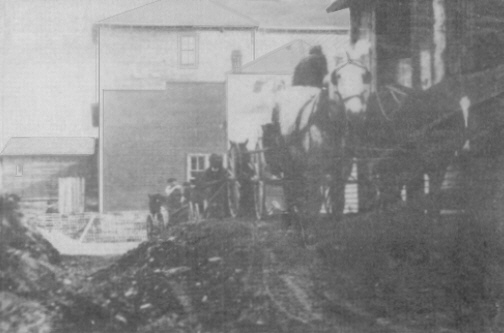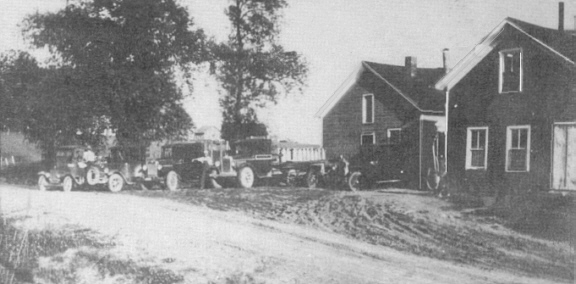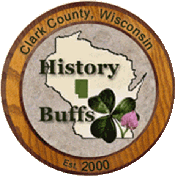Index of
"Good Old Days" Articles
Clark County Press, Neillsville--Transcribed
by Sharon Schulte
June 25, 1997, Page 32
GOOD OLD DAYS
Clark County News
June Dairy Month
June is Dairy Month and Clark County holds a great history in the dairying industry. It seems appropriate that the "Good Old Days" includes a dairy related story this month.
Most of our countryís early immigrants came here with the desire to find a place of their own or to experience living in the land of freedom.
A teenager of Switzerland, Herman Hediger, desired some adventure, dreaming of traveling to other countries, such as hunting wild animals on an African Safari. A young neighbor had left their Switzerland community, sending back word of his exciting and profitable life in the wilds.
|

Herman
Hediger's first employment after arriving in Clark County, from
Switzerland, in the early 1920s, was at the Zbinden Cheese Factory located
on the southwest corner of Grand Avenue and Seventh Street, Neillsville.
The patrons hauled milk by horse and wagon to the factory. Van Gorden's
feed mill is visible in the background, across the street. |
Young Hediger, age 17, respected his fatherís decision, "No, he would not be allowed to journey to Africa." After all, his dadís word was the law. A short time later, news came from America. A former young neighbor woman, an acquaintance of Hedigerís sister, wrote of opportunities in Clark County, Wisconsin. For adventure that was better than remaining home where opportunities were few, Hediger approached his father with the request that he be allowed to sail to America. His father consented along with a few words of advice, "Youíll be far away and on your own. I wonít be able to come and help you."
With those words, young Hediger left the homeland, arriving in Neillsville, having $16 in his pocket. Included in his opportunities for adventure was his lack of knowledge of the English language. He knew the German language as spoken in Switzerland, but not the English language of Clark County.
A job was waiting for Hediger, working at a cheese factory on the corner of Grand Avenue and Seventh Street. Walter Zbinden and his wife were making cheese, and needed help in their growing business. Zbindenís wife had written the letter sent to the Swiss relatives and its news had inspired Hedigerís move to America. Zbindens were making a modest profit with cheese prices at 26-1/2 cents per pound. Hediger had a good start in working for them and learning the trade when the cheese dropped to 12-1/2 cents. The Zbindens could no longer afford him; Hediger was out of a job.
The unhappy news reached his father, who wrote to the son: "Sell shoestrings, suspenders or brooms, but never be a public charge when you are out of work".
By the time the letter of advice reached Hediger, he was at work in the Cannonville factory. Zbinden had found a job for him, in a factory where he could understand and be understood. The German language was spoken as well as English. Zbindenís lost a lot of milk during the period of low prices, but eventually the market became better. The milk customers came back and so did Hediger.
Hedigerís beginning salary with Zbindens was $30 per month plus board.
His return to the Zbinden cheese factory was at the time they started making Swiss cheese, the first Swiss to be made commercially in Clark County. That type of cheese was an old story for Hediger, for his work and skill he was paid $60 per month. Milk was received twice a day from each patron, requiring him to arise at 4 a.m., and occasionally 2 a.m.
|

Hediger started as
manager in the old Christie Cheese Factory across from the Halle farm
about one and a-half miles east of Hwy 73 on Panther Creek Road. He was
the first to introduce trucks with a snowplow attachment for hauling milk. |
The desire for his venture lured Hediger to manage an old Christie-area factory, located on the Charles Shaw and Fred Babbe farm lines, across from the Arnold Halle farm.
The rural factory setting didnít compare to the city factories. A multitude of inconveniences such as a run down building which was merely a shed, and often surrounded by deep mud. To make the area passable, Hediger obtained cinders from the condensery. He sifted the cinders, using fine cinder siftings for fill around the building and the remaining coarse cinders for fuel, in making steam. Picking up the cinders served two purposes, suitable for fuel and ground fill. Also, he was able to haul tree stumps from farms of patrons who were glad to have him clear their land. He brought the stumps home and cut them up by hand for the factory boiler.
As there was no electrical power, Hediger depended on light from kerosene lanterns and lamps. He cut curds with a hand-operated curd mill. He cranked the mill with one hand and fed in the curd with the other hand.
When undertaking the factory venture, Hediger worried about the accounting part and handling the money. The patrons assured him they would manage that part of the business and handle the money. Some cash had been unaccounted for with previous managers, so the new system suited patrons and manager.
Hedigerís agreement in the new enterprise was to do all the work, furnish the building and supplies. He rented the building and equipment. A savings of $375 was used plus a loan of $750 from the Neillsville Bank to get started in the business. Herman North, of the bank, and Hediger began a lasting business and personal friendship starting with the $750 loan transaction.
Through Hedigerís hard work and finding a Chicago market paying one cent higher for cheese, he met his expenses and eventually paid off a $1,000 deficit created by a previous factory manager. He was not quite 20 years old when he took on the business challenge. Liking the Clark County area, he decided to stay and staying would require establishing integrity and dependability with the farms he was serving.
In 1924, Hediger injured his back having to quit the factory and returned to Switzerland for osteopathic service. He returned, working briefly for the Zbindens, and then bought the Christie factory which he had previously rented.
Hediger and other cheese makers faced the competition of the incoming American Stores retail chain which had purchased the condensery in Neillsville. A meeting of surrounding cheese makers was called by the American Management, which offered to buy any or all of them.
Some of the cheese makers resisted the buyout offer. Hediger considered it wise to sell, accepting a reasonable settlement. The Zbindens sold a few months later.
A deal was made between American and Hediger. Hediger would haul milk from his former patrons to the Neillsville plant. Previously, he had been the first in Clark County to haul logs on a truck for Tibbett, a local logger, so once again he was in a trucking business.
For his hauling, Hediger had bought a large snow plow, used on a heavy truck. Up to this time, the city of Neillsville had plowed the streets with horses, resisting efforts to use power driven equipment. One evening, Hediger loaned his equipment to Tubby Radtke for clearing Neillsville streets after a snowfall. The City soon purchased their own power-driven equipment.
While out of the dairy business a few years, Hediger bought a farm on Christieís southwest side in 1929.
In December of that year, the Crash came, an unhappy truth to be revealed Ė he bought too soon. The value of the farm skidded downward.
The country was still depressed when Hedigerís five-year hauling contract with American Stores Dairy Company expired. He became free to go back into the cheese factory business and he lost no time in starting. In readiness for the venture, he had a modest factory structure built on to the farm home, in which equipment was installed and a cheese operation would carry on. His business started with eight patrons and 1,200 pounds of milk. The arrangement with the patrons was they paid Hediger 2-3/4 cents per pound of cheese made, plus one-half of receipts from whey cream. At the end the first full month, the patrons received $216, Hediger $17.60. The business gradually grew with a volume of 56,000 pounds per day in 1957.
Hediger had a good helpmate with the cheese factory business and throughout most of his life here.
In March of 1928, he married Hannah Harder. They knew of one another while living in Switzerland but didnít formally meet until Hannah, working as a governess in New York, traveled to Clark County to visit her brother, Henry, a farmer in the Christie area. Reminiscing, they told of their wedding day Ė leaving after the morning factory jobs were done, driving to Winona, Minnesota, to be married and returning late in the afternoon to finish up the dayís batch of cheese. In other words, they didnít miss any factory work on their wedding day.
Cheese and butter making had many phases to the operation and required more than one worker. Hannah assisted her husband, being responsible for certain duties such as lining butter boxes, doing all of the butter packing, washing separators, tanks and utensils. She helped do the milk testing and when her husband was gone driving truck, she was capable of seeing that the cheese or butter making process, in the factory, was completed as scheduled.
The Hedigers had three daughters: Hannah, Margarate and Rose, and three sons, Herman, Jr., Kurt and Fritz.
Hedigers started phasing out of the milk processing business in the early Ď60ís. They were actively involved in the community where they lived. Herman Hediger passed away in 1972 and his wife, Hannah, died in 1993.
The Hediger Cheese Factory business is gone but the name "Hediger" remains in the area.
Friends of the Old School, Owen
Recently, I attended a Friends of the Old School meeting at Owenís Millpond Park and the Historic old school building. An ambitious group of members, numbering over 125, are actively working and supporting the restoration project of the school. They are to be commended for their efforts as the community will benefit from the historic facilities availability. Fittingly, the historic Yellowstone Trail runs east and west past the schoolís front door.


